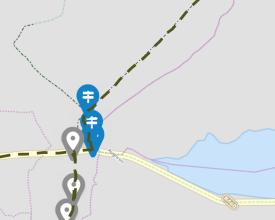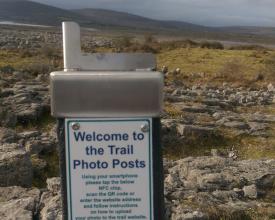Digital Recreational Site management system using a dedicated app and web based backend

Utilising smartphone technology to develop the first dedicated digital outdoor recreational and environmental site management system. It replaces the current general disparate and mainly paper based management systems outdoor recreation sites with an integrated digital system. It ensures that multiple bodies, agencies and community groups who are all involved in managing an outdoors recreational site can use the one system. The system is offered on a "fremium" model to community groups and this is subsidised by Government agencies who pay for the system.
positive impacts:
- smartphone based transcribing from paper.
Works on android and apple devices and has built in maps so no mobile coverage is needed out in the field
- all users of the system are linked back to a user ID so recording can be authenticated
- all monitoring reports and remedial actions are stored securely in "the cloud
- geolocating all data allows detailed reporting and makes year on year comparisons (i.e viewing effects of programs tacking invasive species)
Context
Challenges addressed
Environmental
Managing a large site with multiple owners
The system has been designed to manage outdoor spaces like recreational trails and National Parks. These can be massive area’s with a number a mixture of public and private bodies involved.
Management of invasive species
Invasive species are very damaging environmentally. They can be hard to manage because they ignore boarders and ownership lines.
Social
Covid has shown the world the importance of outdoor spaces. During lockdowns people were locked in their houses and apartments with negative social impacts. The outdoor spaces allow freedom and fresh air and the system ensures the user gets what they expect.
Volunteers
The system allows the setting up of "volunteer wardens" to feed back into the system.
Economic
The system was developed in Ireland and we see trails and outdoor recreation spaces as economic drivers for rural area's. The world including Ireland has seen a decline in rural living with the draw of big cities.
Location
Process
Summary of the process
Innovation is useless without the partnership to implement and manage them. When you have good leadership and all partners forcused on the same goal you can make good progress.
Communication between partners and keeping them up to date is essential. You must be willing to try new innovative ideas and not give up if they fail the first time
Building Blocks
Partnership
Through this project I have brought together a number or local and national partners:
Organisation
Burren Geopark
Clare Local Development Company
Dept of Rural & Community Affairs
National Parks and Wildlife Service
Purpose
Each partner has either a local or national remit for an area in the project. By bringing them together we pool the resources and knowledge to deliver the system
Enabling factors
Coordinging
The bringing together of all the bodies with each focusing on a specific area. As each partner joined they added an element to the system and then the other partners gained this feature.
These are public government funded bodies and the features they pay for are given provided to local comunities in a fremium model offering
Resources
Each organisation has resources and contacts that are utilised in the project.
Lesson learned
The main lessons were:
- make sure you are meeting with a person who can make a decision
- show the benefits of the system
- show the advantages of the colaborative approach (tide rises all boats etc)
- give all partners credit as the program progresses
- analysis what a partner can give (they may be able to contribute time / work instead of financial)
Resources
Innovation
The project had a number of innovative elements. It brought together the elements of a smartphone (camera, gps, dropdown menu's) and designed a recreational site management system to utilise them - this is a world first.
It is an open system so additional devices can be added - people counters, flood monitors all via Internet of things (IOT)
Enabling factors
- trusted local company to work on the project was essential
- worldwide approach to sourcing and ideas (IOT devices sourced from New Zealand)
- having a project manager of 13 years outdoor recreation expierence and an innovatie thinker to develop and drive the project
Lesson learned
Partner implementing company
We worked previously with a company that didn't work out as they were only commited to the research phase rather than the project inisiative and management phase
Keep up to date
The area is changing quickly so it is important to keep watch for new developments and have a platform that can integrate them
Impacts
Environmental
Managing a large site with multiple owners
All relevant bodies can use the system to manage their section of a recreational site. With each body using the same system you get a consistent standard of information flow which makes the overall management more efficient and accurate
Biodiversity
The system allows users to log the location of invasive species. It helps with the identification and quantifying the infestation. The basemap will show additional information like watercourses so you can use this to prioritise the addressing of the invasive species – watercourses can spread spores of invasives. Funding has been secured to enhance this element further to manage the invasive species so in addition to the identification and geolocating it will also document the work to eradicate the invasives, it will allow users to record the stages of treatment and manage the progress
Social
The digital system can give you up to date information on the condition of recreational sites (i.e if an issue is reported, the area can be closed and locals and visitors can be guided to an alternative site)
Economic
Economic drivers for rural areas
The trails and outdoor spaces "slow people down" which means they stay longer in an area and spend money which contributes to the local economy. This will only work if the trails and outdoor spaces are in good condition and this is what the system delivers.
Beneficiaries
- General Public
- Local indigenous people
- Environment
- Outdoor Recreational Site Managers
- Insurers
Sustainable Development Goals
Story
I work for a charity in Ireland managing OUtdoor recreational trails. We spend a lot of time managing the trails for health and safety issues and then general upkeep. This was done via a number of paper reports, digital camera's and standalone GPS's to record the location. It was a very ineffiecent process and after a high profile accident claim in the High Court in another part of Ireland the deficiancies were highlighted. Over a number of years I worked on a digital solution enbracing new technologies and make the system available to purchase for those who can afford it (National bodies like Coillte (Irish Forestry Service) and then working on a "freemium" model for community lead trails.


